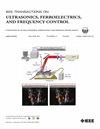Self-Supervised Optimization of RF Data Coherence for Improving Breast Reflection UCT Reconstruction
IF 3.7
2区 工程技术
Q1 ACOUSTICS
IEEE transactions on ultrasonics, ferroelectrics, and frequency control
Pub Date : 2025-06-23
DOI:10.1109/TUFFC.2025.3581915
引用次数: 0
Abstract
The reflection ultrasound computed tomography (UCT) is gaining prominence as an essential instrument for breast cancer screening. However, reflection UCT quality is often compromised by the variability in sound speed across breast tissue. Traditionally, reflection UCT utilizes the delay-and-sum (DAS) algorithm, where the time of flight (TOF) significantly affects the coherence of the reflected radio frequency (RF) data, based on an oversimplified assumption of uniform sound speed. This study introduces three meticulously engineered modules that leverage the spatial correlation of receiving arrays to improve the coherence of RF data and enable more effective summation. These modules include the self-supervised blind RF data segment block (BSegB) and the state-space model-based strong reflection prediction (SSM-SRP) block, followed by a polarity-based adaptive replacing refinement (PARR) strategy to suppress sidelobe noise caused by aperture narrowing. To assess the effectiveness of our method, we utilized standard image quality metrics, including peak signal-to-noise ratio (PSNR), structural similarity index measure (SSIM), and root mean squared error (RMSE). In addition, coherence factor (CF) and variance (Var) were employed to verify the method’s ability to enhance signal coherence at the RF data level. The findings reveal that our approach greatly improves performance, achieving an average PSNR of 19.64 dB, an average SSIM of 0.71, and an average RMSE of 0.10, notably under conditions of sparse transmission. The conducted experimental analyses affirm the superior performance of our framework compared to alternative enhancement strategies, including adaptive beamforming methods and deep learning-based beamforming approaches.改进乳房反射UCT重建的射频数据相干性自监督优化。
反射超声计算机断层扫描(UCT)作为一种重要的乳腺癌筛查手段正日益受到重视。然而,反射UCT的质量往往受到声音在乳房组织中的变异性的影响。传统上,反射UCT采用延迟和和(DAS)算法,其中飞行时间会显著影响反射射频(RF)数据的相干性,这是基于一个过于简化的均匀声速假设。本研究介绍了三个精心设计的模块,它们利用接收阵列的空间相关性来提高射频数据的相干性,并实现更有效的求和。这些模块包括自监督盲射频数据段块(BSegB)和基于状态空间模型的强反射预测块(SSM-SRP),然后是基于极性的自适应替换改进(PARR)策略,以抑制孔径变窄引起的副瓣噪声。为了评估我们的方法的有效性,我们使用了标准的图像质量指标,包括峰值信噪比(PSNR)、结构相似指数测量(SSIM)和均方根误差(RMSE)。此外,采用相干系数(CF)和方差(Var)来验证该方法在射频数据级增强信号相干性的能力。研究结果表明,我们的方法大大提高了性能,实现了平均PSNR为19.64 dB,平均SSIM为0.71,平均RMSE为0.10,特别是在稀疏传输条件下。实验分析证实,与其他增强策略(包括自适应波束形成方法和基于深度学习的波束形成方法)相比,我们的框架具有优越的性能。
本文章由计算机程序翻译,如有差异,请以英文原文为准。
求助全文
约1分钟内获得全文
求助全文
来源期刊
CiteScore
7.70
自引率
16.70%
发文量
583
审稿时长
4.5 months
期刊介绍:
IEEE Transactions on Ultrasonics, Ferroelectrics and Frequency Control includes the theory, technology, materials, and applications relating to: (1) the generation, transmission, and detection of ultrasonic waves and related phenomena; (2) medical ultrasound, including hyperthermia, bioeffects, tissue characterization and imaging; (3) ferroelectric, piezoelectric, and piezomagnetic materials, including crystals, polycrystalline solids, films, polymers, and composites; (4) frequency control, timing and time distribution, including crystal oscillators and other means of classical frequency control, and atomic, molecular and laser frequency control standards. Areas of interest range from fundamental studies to the design and/or applications of devices and systems.

 求助内容:
求助内容: 应助结果提醒方式:
应助结果提醒方式:


